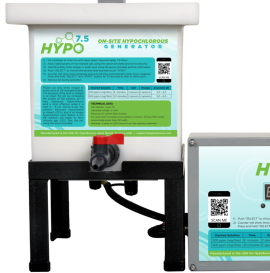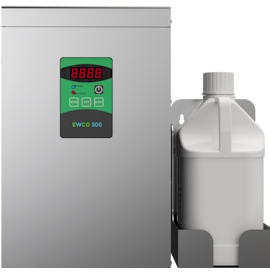الأبحاث > مُصطح البحث: "Staphylococcus"
الأسماء الشائعة لمحاليل حمض هيبوكلوروس
- Electrolytically Generated Hypochlorous Acid
- Neutral Electrolyzed Water (NEW)
- Electrolyzed Oxidizing Water (EOW)
- Electro-chemically Activated Water (ECA)
- Super-oxidized water (SOW)
النتائج: 35 المقالات المنشورة

Microbe(s): Staphylococcus aureus, Pseudomonas aeruginosa

Microbe(s): Acinetobacter baumannii, Staphylococcus aureus, Pseudomonas aeruginosa

Microbe(s): Staphylococcus aureus, Pseudomonas aeruginosa

Microbe(s): Staphylococcus aureus, Pseudomonas aeruginosa

Microbe(s): Staphylococcus aureus, coagulase-negative staphylococci (CNS), Pseudomonas aeruginosa

Microbe(s): Propionibacterium acnes, Corynebacterium, Staphylococcus aureus, Staphylococcus epidermidis

Microbe(s): Staphylococcus aureus

Microbe(s): Staphylococcus aureus, Escherichia coli

Microbe(s): Escherichia coli O157:H7, Listeria monocytogenes, Staphylococcus aureus, and Salmonella Typhimurium

Microbe(s): Escherichia coli, Salmonella enteritidis, Staphylococcus aureus

Microbe(s): Methicillin-resistant Staphylococcus aureus, MRSA

Microbe(s): Acinetobacter baumannii, Escherichia coli, Enterococcus faecalis, Klebsiella pneumoniae, Pseudomonas aeruginosa, Staphylococcus aureus, Bacillus subtilis, Myroides spp, MRSA, VRE

Microbe(s): Total Microbial Count

Microbe(s): Staphylococcus aureus, Bacillus cereus, Escherichia coli, Aspergillus fumigatus

Microbe(s): Salmonella enteritidis, Escherichia coli O157:H7 and Staphylococcus aureus

Microbe(s): Acinetobacter baumannii, Escherichia coli, Enterococcus faecalis, Klebsiella pneumoniae, Pseudomonas aeruginosa, Staphylococcus aureus, MRSE, VRE Bacillus subtilis, Myroides spp.

Microbe(s): Total Microbial Count, methicillin-susceptible Staphylococcus aureus (MSSA), methicillin-resistant Staphylococcus aureus (MRSA)

Microbe(s): Salmonella typhimurium, Listeria monocytogenes, Staphylococcus aureus, Escherichia coli

Microbe(s): Staphylococcus epidermidis

Microbe(s): Staphylococcus aureus

Microbe(s): Staphylococcus aureus

Microbe(s): Escherichia coli O157:H7, Staphylococcus aureus

Microbe(s): Escherichia coli O157:H7, Listeria monocytogenes, Staphylococcus aureus, Salmonella Typhimurium

Microbe(s): Escherichia coli O157: H7, Staphylococcus aureus

Microbe(s): Salmonella Enteritidis, Escherichia coli, Staphylococcus aureus, Listeria monocytogenes, and Bacillus cereus

Microbe(s): Escherichia coli, Staphylococcus aureus, Salmonella spp.

Microbe(s): Escherichia coli, Staphylococcus aureus

Microbe(s): Escherichia coli, Staphylococcus epidermidis

Microbe(s): Escherichia coli, Salmonella typhimurium, Staphylococcus aureus, Listeria monocytogenes, and Enterococcus faecalis

Microbe(s): Escherichia coli, Listeria monocytogenes, Pseudomonas aeruginosa, Staphylococcus aureus

Microbe(s): Escherichia coli, Listeria monocytogenes, Pseudomonas aeruginosa, Staphylococcus aureus

Microbe(s): Salmonella typhimurium, Staphylococcus aureus, and Listeria monocytogenes, Escherichia coli

Microbe(s): Staphylococcus, Staphylococcal enterotoxin-A

Microbe(s): Enterobacter aerogenes, Staphylococcus aureus

Microbe(s): Staphlycoccus Aureus
Best Hypochlorous Acid (HOCL) Generators
 Portable Hypochlorous Acid (HOCL) Machine
Portable Hypochlorous Acid (HOCL) Machine
Make high quality hypochlorous acid in the home or office.
$159.99 + Free Shipping
 HOCL Machine + Electrostatic Sprayer
HOCL Machine + Electrostatic Sprayer
Make hypochlorous acid and spray with an electrostatic cold fogger.
$309.98 + Free Shipping


